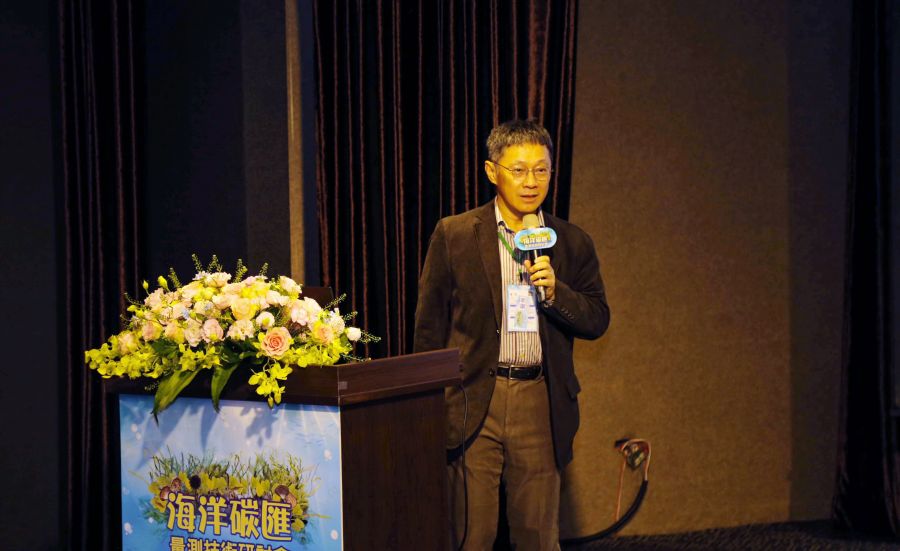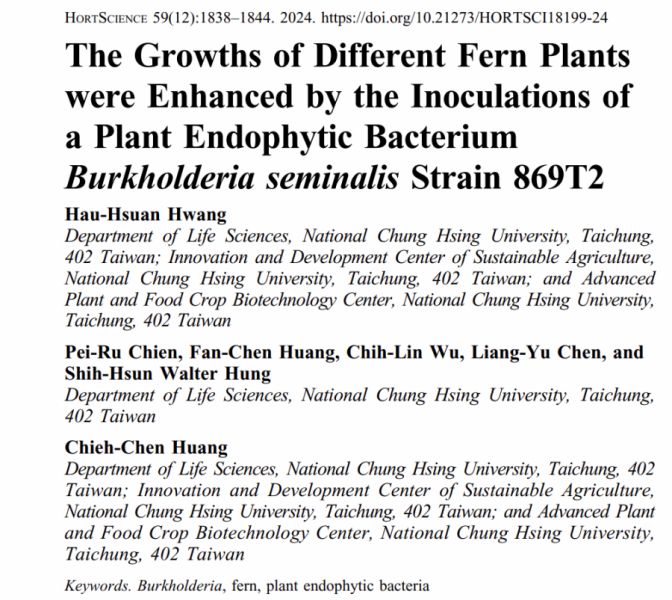| 論文篇名 | 英文:Factors regulating carbon sinks in mangrove ecosystems 中文:影響紅樹林碳匯的因素 |
| 期刊名稱 | Global Change Biology |
| 發表年份,卷數,起迄頁數 | 2018, 24(9), 4195-4210 |
| 作者 | Li SB, Chen PH, Huang JS, Hsueh ML, Hsieh LY, Lee CL, Lin HJ*(林幸助) |
| DOI | 10.1111/gcb.14322 |
| 中文摘要 | 國立中興大學生命科學系教授林幸助研究團隊用四年時間,量化臺灣西海岸北、中與南部主要紅樹林生態系的碳循環,發現臺灣紅樹林儲碳能力高於全球平均值,為陸地森林的6倍,而分解作用是決定紅樹林碳儲存量的關鍵,解開紅樹林儲存藍碳的神秘面紗。林幸助表示,將二氧化碳保存在「藍碳」中被認為是現今減緩大氣中二氧化碳升高及全球暖化的可行方法之一。所謂「藍碳」指的是保存在海洋生態系統中的碳。相較於陸地森林中的「綠碳」,「藍碳」因為海洋底土環境特性,可以有效累積更多碳。全球重要的「藍碳」是紅樹林,分布在熱帶與亞熱帶沿岸海域,被認為是熱帶森林中含碳量最豐富的生態系統之一,因為有機碳不但可以儲存於其樹幹中,亦能保存於深達3公尺的底土內。紅樹林雖然只佔全球熱帶森林面積的0.7%,全球陸地面積的0.1%,但是其生產力可占全球沿岸生態系統的一半。紅樹林碳儲存量比鹽沼、海草床、泥炭土及其他主要森林還要多。雖然如此,各界目前對於紅樹林碳吸收與儲存機制仍不了解。此研究團隊陸續量化了臺灣西海岸北、中與南部主要紅樹林生態系,包括台北淡水河、彰化芳苑以及台南七股中水筆仔與海茄苳的生物量、生產量、落葉量、碎屑輸出量以及分解速率,整合建構了各紅樹林的碳循環收支模式。研究結果發現,環境因素比樹種更能影響紅樹林碳循環。臺灣兩種優勢紅樹林樹種因為樹密度高,每年每公頃可吸收高達100公噸的二氧化碳,不但高於全球平均值,也是陸地森林的6倍。其中一半吸收的碳儲存於樹幹中,另一半則以枯枝落葉形式掉落於地上。高達83%的掉落地上的枯枝落葉會在一年內分解,然後以顆粒態或溶解態的有機碳經由潮水帶出紅樹林,提供鄰近海域生態系食物來源。因為多數枯枝落葉很快被分解,只有7%所吸收的碳能儲存於紅樹林底土內,因此,分解作用是決定紅樹林碳儲存量的關鍵因子。林幸助建議,海岸管理應該要將紅樹林高效率的碳儲存能力以及餵養周遭海洋生物的生態功能列入考量。研究另發現汙染嚴重、高度缺氧的淡水河,已影響到其紅樹林碳循環,不但降低其碳吸收力,甚至讓整個紅樹林轉變為碳排放系統。此外,團隊進一步利用穩定同位素技術追蹤發現,紅樹林底土內所儲存的碳並非全來自於紅樹林本身所吸收量,反而多數是來自於上游河川或鄰近草澤所生產的有機物,因淤積在紅樹林所在河口而形成,推翻過去所認為的觀念。 |
| 英文摘要 | Mangroves are recognized as one of the richest carbon storage systems. However, the factors regulating carbon sinks in mangrove ecosystems are still unclear, particularly in the subtropical mangroves. The biomass, production, litterfall, detrital export and decomposition of the dominant mangrove vegetation in subtropical (Kandelia obovata) and tropical (Avicennia marina) Taiwan were quantified from October 2011 to July 2014 to construct the carbon budgets. Despite the different tree species, a principal component analysis revealed the site or environmental conditions had a greater influence than the tree species on the carbon processes. For both species, the net production (NP) rates ranged from 10.86–27.64 Mg C ha-1 yr-1 and were higher than the global average rate due to the high tree density. While most of the litterfall remained on the ground, a high percentage (72–91%) of the ground litter decomposed within one year and fluxed out of the mangroves. However, human activities might cause a carbon flux into the mangroves and a lower NP rate. The rates of the organic carbon export and soil heterotrophic respiration were greater than the global mean values and those at other locations. Only a small percentage (3–12%) of the NP was stored in the sediment. The carbon burial rates were much lower than the global average rate due to their faster decomposition, indicating that decomposition played a critical role in determining the burial rate in the sediment. The summation of the organic and inorganic carbon fluxes and soil heterotrophic respiration well exceeded the amount of litter decomposition, indicating an additional source of organic carbon that was unaccounted for by decomposition in the sediment. Sediment-stable isotope analyses further suggest that the trapping of organic matter from upstream rivers or adjacent waters contributed more to the mangrove carbon sinks than the actual production of the mangrove trees. |
【學術亮點】影響紅樹林碳匯的因素 2018-05-23

生態農業:農業溫室氣體減量【生命科學系林幸助教授】






